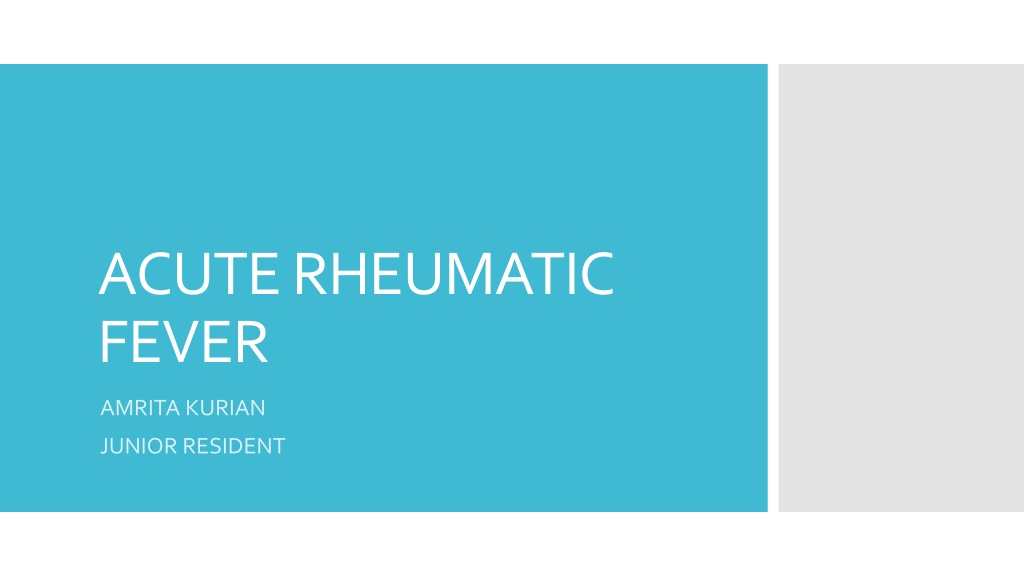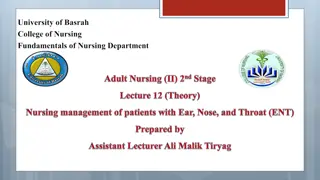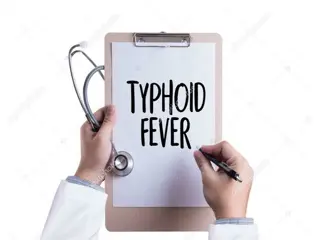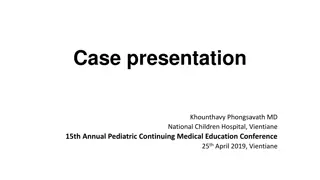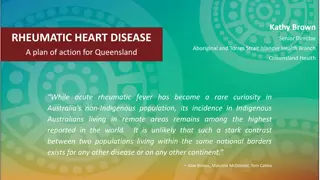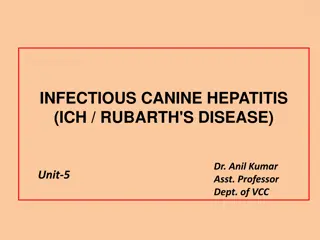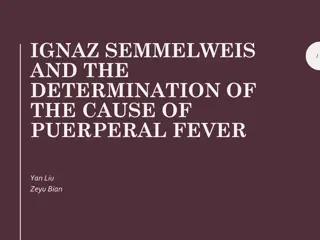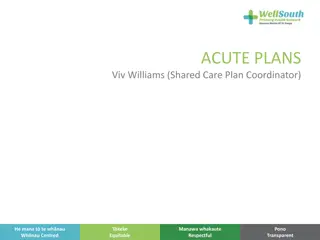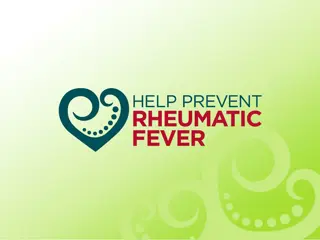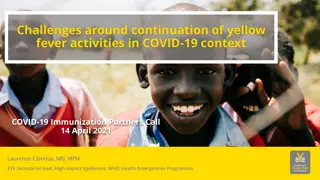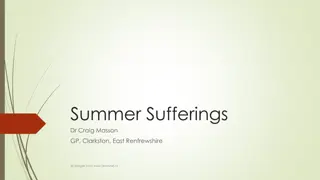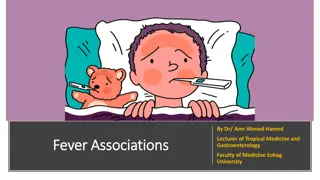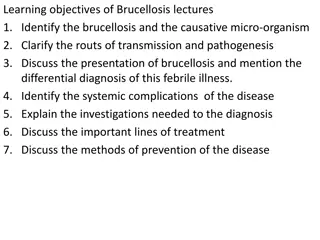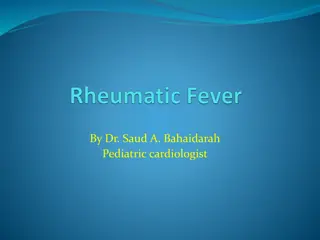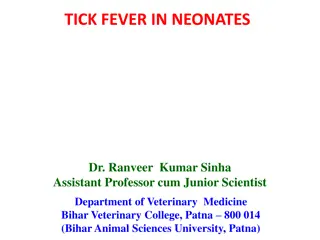Understanding Acute Rheumatic Fever: Causes, Symptoms, and Impact
Acute Rheumatic Fever (ARF) is a multisystem disease resulting from an autoimmune response to a sore throat caused by Group A beta-hemolytic Streptococci. It primarily affects children aged 5-14 years and can lead to rheumatic heart disease (RHD), which is the most common cause of heart disease in children in developing countries. Although the incidence of ARF is declining in the Western world due to improved living conditions and the introduction of antibiotics, it remains a significant health concern in developing nations. ARF can lead to cardiac valvular damage, with potential long-term consequences like heart failure. Early detection and proper management are crucial in preventing severe complications.
Download Presentation

Please find below an Image/Link to download the presentation.
The content on the website is provided AS IS for your information and personal use only. It may not be sold, licensed, or shared on other websites without obtaining consent from the author. Download presentation by click this link. If you encounter any issues during the download, it is possible that the publisher has removed the file from their server.
E N D
Presentation Transcript
ACUTE RHEUMATIC FEVER AMRITA KURIAN JUNIOR RESIDENT
Rheumatic fever licks the joints and bites the heart -Ernst Charles Lasegue
Multisystem disease resulting from autoimmune response to sore throat caused by Group A beta hemolytic Streptococci (GAS) ? Almost all manifestations are reversible except for cardiac valvular damage (RHD)
Disease of poverty EPIDEMIOLOGY Declining incidence in the western world Improved living conditions Introduction of antibiotics (supplemental effect)
RHD is the most common cause of heart disease in children in developing countries 15 to 19 million cases of RHD in the world with 2.5 lakhs deaths every year 95% of Acute Rheumatic Fever ( ARF ) cases and RHD deaths now occur in developing countries Highest incidence of RF in the world : KYRGYZSTAN : 543/1 L/year INDIA: 8.4/1 L/ year (moderate high incidence)
ARF affects children of age 5 -14 years; rare in persons aged >30years Prevalence of RHD peaks between 25 -40 years Males = Females (ARF) Females > Males even upto2:1 (RHD)
1. Among 100 sore throats only 30% are caused by GAS SEQUENCE OF EVENTS 2. After a latent period of 2-3 weeks: 0.3 to 3% of streptococcal sore throat develop ARF 3. Resolves within 3 months even without treatment
4. Patient continues in the same environment ; recurrent attacks of rheumatic fever 5. Cumulatively damages the heart : RHD 6. Over many years : Heart failure
AGENT HOST ENVIRONMENT
Agent : Group A beta hemolyticstreptococci AGENT FACTORS Classically the M serotypes 1,3,5,6,14,18,19,24,27 and 29 were associated with ARF, but now in high incidence regions, any serotype has the potential to cause ARF
3-6 % of any population is susceptible to ARF regardless of geography /ethnicity Familial aggregation: If parents have RF, 5 times higher risk of RF HOST FACTORS Monozygotic twins: 6 times higher risk than dizygotes Heritabilityof RF: 60% HLA DR 4and 7:susceptible HLA DR 5,6,51,52 and DQ: protective
Overcrowding Poor housing Poverty Lack of awareness ENVIRONMENT Rural location Reduced access to health care
ANTIBODY MEDIATED RESPONSE : Host produces antibodies against Group A streptococcal carbohydrate epitope N acetyl Beta D glucosamine MOLECULAR MIMICRY CROSS REACTS WITH CARDIAC ANTIGENS Cardiac antigen Laminin on heart valve endothelium
T CELL MEDIATED IMMUNE RESPONSE Directed against Streptococcal M protein but cross reacts with cardiac myosin
Latent period of approx. 3 weeks Preceding streptococcal infection is commonly subclinical Arthritis Carditis (most common) CLINICAL FEATURES Subcutaneous nodules Chorea Erythema marginatum (least common)
Chorea and polyarthritis NEVER coexist
EARLIER MORE RAPID PROGRESSION TO RHD IN INDIA Usually takes 10 to 20 years to develop significant RHD in Western world In India, as early as 5 years : Malignant course of rheumatic fever
MIMETIC NATURE OF RF The younger you are, more the risk of carditis and the older you are, more the risk of arthritis At age 3, 90% risk of carditis as opposed to the 33% risk of carditis in teenage The predominant manifestation in the initial RF episode recurs in the subsequent episodes
Migratory, asymmetric polyarthritis Migrates over a period of hours Affects large joints ARTHRITIS Predominantly lower limbs : knees > ankle > wrists > hips > elbows Severe pain and disabling Usually resolves within 4 weeks (treated / not treated)
Decreased complements Synovial fluid : Sterile inflammatory fluid X ray : joint effusion, no erosions Dramatic response to NSAIDS (Aspirin) Polyarthralgia follows the same pattern No long term sequelae except for
Jaccoudsarthritis or arthropathy Involvement of articular fibrous capsule, no joint erosions Correctable with physical manipulation No rise in inflammatory markers
DD :POST STREPTOCOCCAL REACTIVE ARTHRITIS Involves smaller joints Short latency ( within 7 to 10 days) Less NSAID responsive Carditis usually absent +/-renal manifestations Rarely progress to RHD: so prophylaxis for 1 year
Latent period of 6 to 8 weeks, even upto6 months SYDENHAMS CHOREA (ST VITUS DANCE) May be the only presenting manifestation in 15% cases More common in females young girls Never seen in post pubertal males Quasi purposeful, particularly affecting the head and upper limbs Jack in the box tongue (darting movements of tongue)
Disappears during sleep Chorea: generalised or restricted Associated emotional lability or obsessive compulsive traits Lasts long : 8-15 weeks, even 1 to 2 years Inflammatory markers may be normal (due to the long latency) Mechanism:immune mediated reaction to auto antibodies of basal ganglia
Milkmaid sign: motor impersistence
Rare :1.5% Delayed manifestation Painless,0.5 2 cm, mobile lumps beneath the skin overlying bony prominences SUBCUTANEOUS NODULES Hands, elbows, knees, ankles, occiput, achillistendon, vertebrae Corresponds to severe active carditis
Classic rash of ARF Trunk and limbs, never over the face Pink macules with a central clearing and a serpiginous spreading edge ERYTHEMA MARGINATUM Evanescent
Pancarditis Valvular damage is the hallmark of rheumatic carditis Traditionally diagnosed by clinical criteria (upto 2015) endocarditis myocarditis pericarditis CARDITIS Valvulitis :Regurgitation MR : PSM (mc) AR: EDM Carey Coomb : MDM increased flow across inflamed mitral valve Cardiomegaly Heart failure S3 Heart blocks and soft S1 Pericardial rub Pericardial effusion
Myocarditis or pericarditis doesnt occur without valvulitis Mitral valve almost always affected +/-aortic valve Isolated aortic valve involvement rare Till 2015, only clinical carditis Drawbacks: inter observer variation, murmur masked by heart failure , shock or tachycardia
Hence the addition of subclinical carditis in 2015 Recommends ECHO for all patients with rheumatic fever that should be serially repeated SEVERE CARDITIS : 60% develop RHD SUBCLINICAL CARDITIS : 18% develop RHD
RHEUMATIC VEGETATIONS : ASCHOFF BODIES ANITSCHKOW CELLS Areas of fibrinoid necrosis plus inflammatory cell infiltrates Firm, adherent, warty, along the lines of closure of mitral valve; inflammatory cell nucleus mimics a caterpillar : CATERPILLAR CELL Most common site: interventricular septum never embolise Indicator of rheumatic carditis
Myocarditis in RF : a myth? Histologically the amount of myocardial damage due to myocarditis is so little that it fails to explain the patient s death No rise in cardiac enzymes Thus heart failure in rheumatic fever : solely due to acute regurgitation
Pericarditis: BREAD AND BUTTER PERICARDITIS Fibrinous Signifies active carditis
DIAGNOSIS Low risk population: ARF incidence 2 per 1 lakh school children or All age RHD prevalence 1 per 1000 population per year Moderate to high risk group: 1 Establish population risk ARF incidence 2 per 1 lakh school children or All age RHD prevalence 1 per 1000 population per year
2 Establish preceding GAS infection Throat swab culture : low yield Rising titre of ASO or anti DNAseB Positive rapid group A carbohydrate antigen test
3 Apply major and minor criteria
Suppressive therapy ie; suppresses the symptoms Doesn t alter the likelihood of developing or the severity of RHD AIMS TREATMENT Minimise the effects of inflammation on heart and joints Eradicate GAS from pharynx Commence secondary prophylaxis Treatment of heart failure, replace the valve if indicated
1 ANTIBIOTICS DOC: Penicillin Phenoxymethylpenicillin 500mg BD or Amoxicillin 50mg/kg (max 1g) for 10 days Single dose of 1.2 million units IM benzathine penicillin G 2 ANTI INFLAMMATORY AGENTS DOC: Aspirinat 50-60mg/kg/day in 4 -5 divided doses (upto 4-8g/d in adults) Once acute symptoms resolve , continued for a further 2-4 weeks Alternative : Naproxen 10-20mg/kg/day
Role of glucocorticoids: only 1 study demonstrated a benefit Current consensus: steroids for significant carditis, heart failure or pericarditis Prednisolone : 1-2mg/kg/day usually for a few days and uptoa max of 3 weeks
CHOREA If moderate to severe : valproate or carbamazepine Continued for 1-2 weeks after symptoms subside In refractory cases: steroids (prednisolone 0.5mg/kg/day) When refractory to all other treatments: IV Ig
Untreated : lasts for 3 months; with treatment : 1-2 weeks Inflammatory markers monitored every 1-2 weeks till they normalise PROGNOSIS ECHO repeated after 1 month to look for progression of carditis Ensure long term follow up and adherence to secondary prophylaxis Entry to local ARF registry
PRIMARY PREVENTION: Primary prophylaxis: timely and complete treatment of GAS sore throat with antibiotics PREVENTION If commenced within 9 days of onset, a course of penicillin will prevent almost all cases of ARF Challenges: 1/3rdcases asymptomatic, in an epidemic 58% asymptomatic DOC: single dose of benzathine penicillin 1.2 million units IM
SECONDARY PREVENTION To prevence recurrences If no prophylaxis: 20% recurrence in the first 5 years and 10% recurrence in the next 5 years DOC: Benzathine penicillin single IM dose every 4 weeks (1.2 MU) Others: Oral penicillin V 250mg BD or sulfonamides Penicillin allergy : erythromycin 250mg BD
After valve surgery: lifelong prophylaxis
